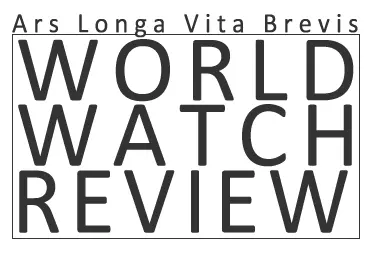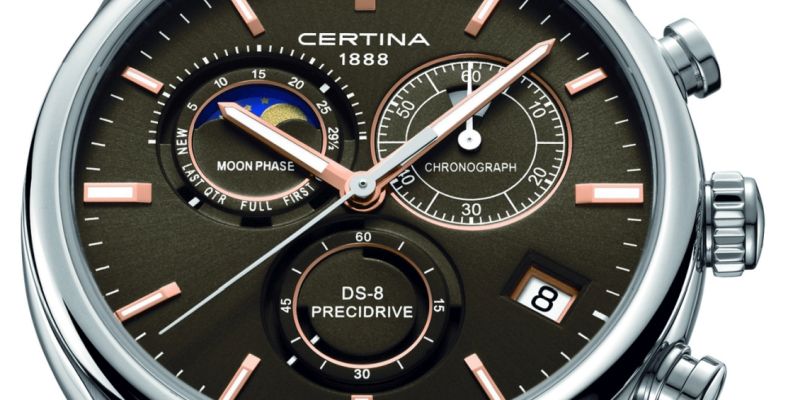
Certina has officially presented the Chronographe DS-8 Phase de Lune during the Baselworld 2015 show. It is a perfect example of a dressy “complication” watch that somehow manages to combine into a single package an almost stunning exterior, a reliable quartz chronograph movement that, for all things practical, blows out of the water almost all advanced electric mechanisms currently available on the market, while spicing all up with a very affordable price. What more do you expect? A free Porsche?
Overall Impression
I don’t know why Certina prefers to use computer-rendered images to accompany their press releases: they never do justice to their timekeepers and this new DS-8 Phase de Lune is no exception here. Although the images give you a fairly good idea of how the gadget’s exterior, in real life, it looks way better and I am pretty sure that a professional photographer can easily capture its natural beauty.
Somehow reminding me of Patek Philippe timekeepers with their layout and general, um, aura, this device leaves a good impression with its soft, noble color scheme and nice textures. Everything is designed with lots of attention to detail with all of the parts nicely complementing each other providing that sort of experience you rarely expect from a quartz-powered timekeeper from a brand, which is supposed to ‘inexpensive’ (and thus uninspiring).
Perhaps, the only thing that irritates me a little is the length of the hour and minute hands in relation to the diameter of the dial cutout. But that’s perhaps all.
Mechanism
The DS-8 Phase de Lune comes equipped with a quartz movement, but that’s not your ordinary, dirt-cheap job that you often see in throw-away pieces with a Mickey Mouse on their dials. This one features a gorgeous ETA G10.962 BH PRD Precidrive mechanism that belongs to their well-known Thermoline family of electric movements.
Automatically compensating for sharp temperature changes, the Thermoline series, which Breitling loves to use to power their analog/digital chronographs (that says something, right?), usually offers an unprecedented level of accuracy that is about ten times better than that of a normal quartz mechanism.
Powered by a standard battery (I wonder why ETA still doesn’t have a movement that would use solar energy to keep itself going), the mechanism has a theoretical autonomy of just over three years, although that could be decreased drastically in case you abuse the chronograph sub-system: it is usually quite taxing on the battery.
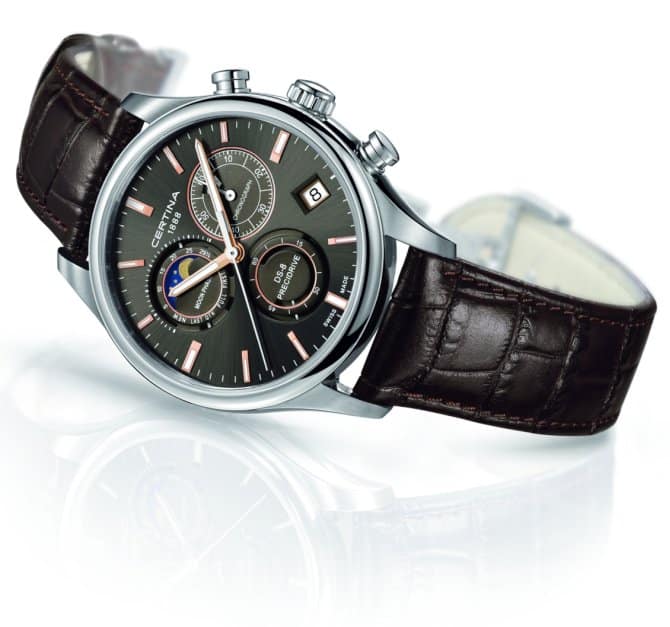
As usual, a manufacturer can fit the base movement with all sorts of complication modules that greatly enhance its functionality. This particular breed features not only the usual chronograph, a simple calendar at 4 hours, and a standard-looking moon-phase display, but also includes an “average length of lunar cycle” indicator that, while not exactly useful, could be of some interest to those who like an extra complication on their watch.
Case
As I have already noted, these promotional renderings don’t do the DS-8 any justice (in both meanings of the word).
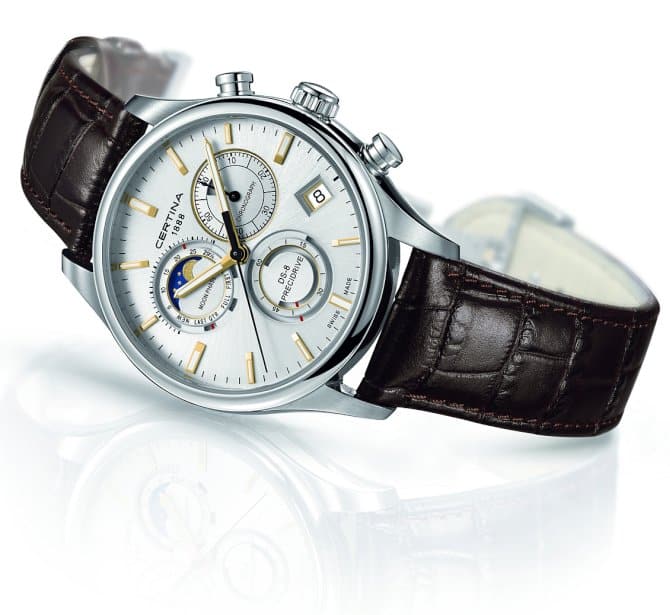
First of all, the case is a lot better sculpted than these pictures show: the bezel is thinner and the crown has a lot better grip than you see here. Whole 41 millimeters in diameter, it is a little bit larger than your normal dressy three-hander, but is, in fact, smaller and especially thinner than an automatic timekeeper stuffed with the same complications.
However, keep in mind that the horns with a beautiful brown leather strap attached to them (stainless steel bracelet is available if you are into this sort of thing) here are rather long making the body measure roughly 50 millimeters lug to lug. Although that is not terribly long, you should understand that the piece may cover the whole width of your wrist (and then some) if you happen to be on a skinnier side.
On the other hand (I am still talking about justice), the case is not as nicely finished as the guy who approved the renders wanted you to believe. Machine-brushed surfaces, unfortunately, lack the level of refinement you expect by looking on the dial. It is precisely there where you can see that this is a product that comes with a modest CHF 765 (CHF 795 for the version on a bracelet) price tag, not a ten times more expensive dressy chronograph from a major brand.
Some of you may be put off by this minor flaw, but I don’t see anything wrong with it: while in most cases you get what you pay for, here you get a lot more. Certina once again proves that it can compete with brands that are better advertised and usually command higher prices. I just don’t want you to set your expectations too high: this is neither a Patek Philippe nor an IWC. It’s a Certina and it is supposed to play within the price niche the guys from marketing assigned it to, which also means cutting corners here and there more often than I would care for.
Dial
The dial, though, is where this timekeeper truly shines. It shines, of course not only with its PVD-treated elements but with the way all of them are put together.
Despite the loads of information you have to process when looking at the dial, you probably won’t feel overwhelmed because the data is well-structured. The PVD rose gold-plated hands clearly stand over a dark background, which is available in black and dark grey (you can even call it anthracite). Even the version with a silver-toned dial still offers enough contrast for the hands thanks to the sunburst finish that makes the product look more expensive.
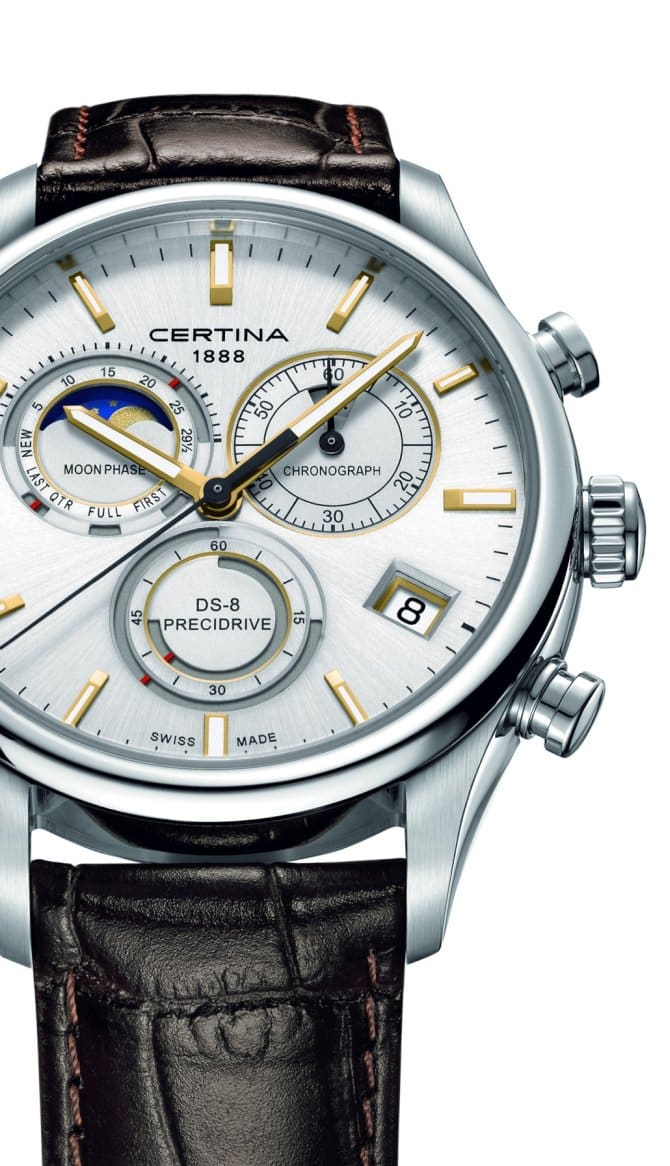
The size of the body is nicely matched to the diameter of the mechanism (the latter measures 29,80 mm in diameter) making the dial look visually light, but not too, well, empty as it often happens when a brand takes a tiny movement, puts it into an oversized body and tries to make you think that it doesn’t look stupid. Here, everything is perfectly balanced: the team of industrial designers that worked on this gadget did a good job.
As I have said earlier, I don’t like the length of the hands: they look just a trifle (maybe, tenths of a millimeter) shorter than they should, but otherwise, everything looks perfect. There is an adequate amount of lume on the hands and hour markers that not only allows you to easier read the dial at night but also make the elements more contrasting in broad daylight.
The fact that a nice sapphire crystal protects the whole assembly from dust and moisture makes things even sweeter.
Price and Availability
The price is probably the best part here. Certina offers the Chronographe DS-8 Phase de Lune at a base price of just CHF 765 for a piece on the leather strap: just $800 at the current exchange rate. And, mind you, this is a recommended price: you will probably be able to snatch one at a small discount even if buying it in a brick-and-mortar shop. The stainless steel bracelet adds just CHF 30 more, although you would possibly be better off getting a bracelet from a third-party manufacturer: this timekeeper deserves a good bracelet.
There is still no info as to the availability, but I don’t think that Certina plans to wait for Christmas before shipping the first batch.
See also: (Unexpectedly) Refined: Certina DS Podium Shape
Photos: Certina
WWR preliminary verdict
Originality 4/5
Build quality: 5/5
Usability: 5/5
Legibility: 4/5
Value for money: 5/5 (and probably even better than that)
Certina Chronographe DS-8 Phase de Lune specification
Price: CHF 765 — CHF 795 (Retail)
Movement: Quartz, Caliber ETA G10.962 BH PRD Precidrive Thermoline, Swiss Made
Number of jewels: 4
Power reserve: Approx. 38 months
Functions: Hours, minutes, seconds, date, chronograph, moon phase, the average length of the lunar cycle
Case: Stainless steel
Shape: Round
Size: 41.00 mm
Dial: Anthracite (C033.450.16.081.00) / Black (C033.450.11.051.00) / Silver (C033.450.16.031.00)
Hour markers: Luminous, PVD-treated
Hands: Rose gold PVD, luminous
Water resistance: 100 meters
Strap: Brown leather strap with twin-pusher butterfly clasp / Stainless steel bracelet
Crystal: Sapphire, antireflective
Back: Solid, DS “Turtle” emblem
